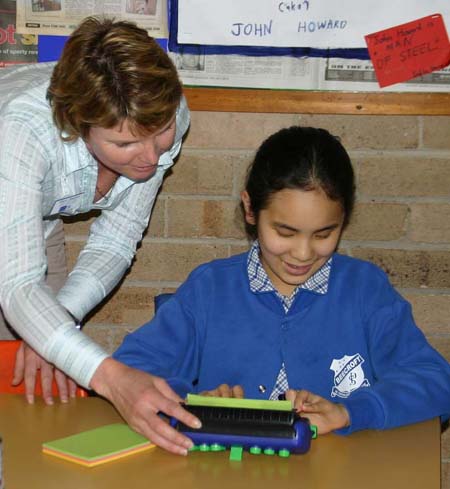The speed of change has become a defining characteristic of the information age in which we live. The socioeconomic impact of this shift is global and far-reaching—connecting people, families, and local communities in new ways, while at the same time, increasing the global connectedness of us all.—Diana Carew, "Educating the 21st Century Citizen,"The Catalyst, April 1, 2004.
According to the World Health Organization, there are an estimated 45 million people in the world who are blind. Approximately 90% live in developing countries and constitute one of the world's most invisible and poorest minorities. For all people who are blind, braille remains the foundation of written communication and is a true literacy medium that cannot be replaced by computer speech or audio. To write braille, assistive technology tools, such as braillewriters, are essential and can be considered an important component of braille literacy. In stark contrast to the vision of the future described by Diana Carew, the International Council for Education of People with Visual Impairment estimates that only 10% of children who are blind in developing countries have access to education or tools for writing braille
It is difficult to write about early braille literacy and writing tools without being seen to be critical of tradition and what has gone before. So it needs stating upfront that the standard mechanical braille-writing tools that are currently in use have provided magnificent service over many decades.
In this information age, we have witnessed fantastic progress in high-tech assistive technology, including braille access to computers and the Internet, personal electronic braille notetakers and personal digital assistants, braille translation and embossing, and much more. These developments in braille assistive technology over the past 25 years have been created primarily by the for-profit sector. On the other hand, mechanical devices for braille writing have remained mostly in the dominion of the nonprofit sector and have effectively been removed from the forces that lead to innovation and improvements in products and cheaper prices.
A New Option for Writing Braille
More than 15 years ago, Quantum Technology (a for-profit company) decided that the lack of choice for early braille-writing options was a worthy challenge, and we set out to develop a small braille-writing device that could be easily carried. We saw the major design challenge as eliminating the need for right-to-left writing (as with the slate and stylus), being able to check what was written and then continue writing, and having a single-piece construction (no stylus to get lost).
In short, our aim was to develop a device that resembled a larger mechanical braillewriter in operation, but was closer to a slate and stylus in size. After many attempts and redesigns, we finally achieved our aim, and the Jot a Dot was launched in 2006. The difficulty of bringing Jot a Dot to fruition has given us some insight into why so few alternatives to the braillewriter have been developed. It really is an engineering challenge to produce braille dots of the right shape and size consistently over a line, using a regular braille keyboard, in such a small product. It was also important to us to have it made of modern materials, lightweight and strong, to ensure that it was truly portable. This could be achieved only by mass manufacturing using injection moulding, a technique that requires a high investment of capital.
Caption: A teacher watching a student use the Jot a Dot.
Our research confirmed that the area of greatest need was in developing countries, where options for braille writing were limited or nonexistent. For this reason, we chose regular-weight paper as the preferred choice for Jot a Dot, since braille paper is rare, if available at all, in many of these countries. We also knew from other projects that good-quality durable braille could be achieved on regular paper, and the cost savings for everyone were significant.
So what has happened since Jot a Dot was released? We have found significant differences in the way Jot a Dot has been received in developed and developing countries. In developed countries, we found that few students are being taught the slate and stylus. The biggest interest so far has come from within education, from teachers and parents who recognize the importance of developing simple notetaking competence as a foundation skill of literacy. Jot a Dot has been welcomed as an addition to the range of tools that teachers use to develop braille literacy skills.
However, Jot a Dot has also highlighted some issues to do with prevailing attitudes and with an apparent lack of willingness to accept change. A frequent question has been this: Does the Jot a Dot replace the slate and stylus? The answer, of course, is no, it is simply another option. Our typical response is to point out that sighted children have literally hundreds of options for writing and scribbling from the earliest possible age. It is inconceivable that anyone would really question whether children who are blind deserve to have a second option.
An Unexpected Response
The really disappointing response has come from blindness agencies and organizations that, we assumed, would have welcomed a new braille writing tool. With the exception of Sight Savers International in the United Kingdom, there has been little or no support from agencies that serve people who are blind in most countries of the world.
Of course, this lack of support would be justified if Jot a Dot did not work or did not make good braille. There are now many hundreds of users around the world, and we have lots of data to support the fact that Jot a Dot is a viable and useful tool for taking braille notes. So we can only conclude that braille writing tools for early literacy are not a high priority or there is too much inertia and conservatism in the agencies that serve the blind community for Jot a Dot to make any sort of impact.
There are other examples of innovative braille-writing technology that has been developed by for-profit organizations and has struggled to be recognized or adopted. A good example is the Tatrapoint Braille Writer, developed in the Slovak Republic. The Tatrapoint is a low-cost mechanical braillewriter that has some important innovations, such as the ability to adjust the spacing of the keys to suit different hand sizes, the ability to use regular or braille paper, and a light touch needed for brailling. It is difficult to understand why devices like the Tatrapoint (which has been around for many years) have achieved such a low profile in the developed world. Attitudes may partly explain it, but the subsidies and financial support offered to more traditional devices may also contribute to the lack of recognition.
Caption: The Tatrapoint Braille Writer.
A Very Different View
In the developing world, Jot a Dot has been the center of a great deal of interest and excitement. As a lightweight and portable device, students are able to use the Jot a Dot at school and carry it home to complete homework. Early in 2007, an evaluation project was completed in Uganda, funded by the Australian government and implemented by Sight Savers International. This project followed 25 students for six months and evaluated how useful Jot a Dot is as a tool for braille literacy. The positive responses have led to the organization of a second project with a larger number of students in Uganda and another trial project planned for Tanzania.
Caption: Ugandan teacher teaching a student to use the Jot a Dot.
We tend to regard assistive technology as being only the high-tech and glamorous end of the spectrum of software and hardware tools that children who are blind or have low vision need. It is time for the low-tech devices to be regarded equally as part of the assistive technology continuum that children who are blind need to compete successfully in education, employment, and life. Braille writing, in the context of early braille instruction, should be recognized for what it is—the foundation of the attitudes, skills, and expectations for technology that children will carry with them for the rest of their lives.
As we head off at great pace into the 21st century, children who are blind will need wider choices and more innovative tools for literacy from the earliest possible age. And we need to consider how they are going to get them.
The vast majority of students who are blind who start braille instruction are presented with a braillewriter that has not changed in more than 50 years, and no one questions this lack of equity and the obvious discrepancy in the expectations for children who are sighted and those who are blind. What would happen if sighted children were presented with a 50-year-old typewriter as their foundation tool for literacy? No matter how good or solid or reliable that typewriter is or whatever proud tradition and history it embodies, their parents would have higher expectations. The parents would expect innovation, change, and choice as a natural extension of the role that technology plays in their own lives. As Carew (2004) suggested, "Change has become a defining characteristic of the information age in which we live."
However, the fact remains that the lack of choice in tools for early braille literacy and of expectations for new ones does not appear to be high on the agenda of blindness agencies in the developed world. If we start with the assumption that everyone who works in the field of blindness is highly committed and motivated and that we all share a common goal of assisting children and adults who are blind, then why is no robust dialogue taking place about this issue?
Is there really such a high level of confidence in the status quo and current braille-writing tools, or are other factors at work? Why do new, innovative options like Jot a Dot, Tatrapoint, and even the Mountbatten Brailler remain outside the mainstream, without subsidy, support, or endorsement from the agencies that control and influence early education and policy?
And why has innovation in the information age failed to provide the technological advances in braille writing that would result in new and cheaper products that are needed by children and adults who are blind in developing countries? It is a tragedy of epic proportions that millions of children around the world still have no tools for literacy.
It is more important than ever that we reflect on these questions and find a way forward for all children who will need better tools, skills, and expectations for their future in this increasingly technological world. Perhaps one way forward is to consider pooling the talents and strengths of for-profit and nonprofit organizations. Matching the innovative culture of the for-profit to the established and far-reaching infrastructure of the nonprofit may provide the platform and incentive for new braille-writing options to be developed. There is always a high cost of development for any new product, which is typically matched by the cost of commercialization and distribution. The nonprofit sector provides an opportunity for a low-cost distribution model, which would result in cheaper products being more widely distributed. Such partnerships should have as their focus the process of innovation and not revolve around a single product. If any nonprofit agency is listening, we would like to talk to you!
Children who enter school in 2008 will graduate from high school in 2021. What will their world be like? I can guarantee that it will be a world in which technological skills are critical to success, and the foundation for these skills needs to be imprinted from the earliest possible age. Children who are blind need to explore, play with, and use assistive technology options, both high tech and low tech, as soon as they can crawl. And they need choices—lots of them. Who is up to the challenge?


